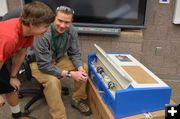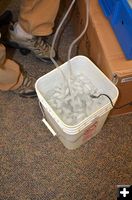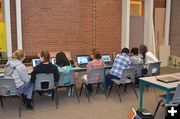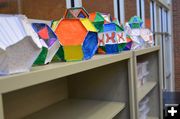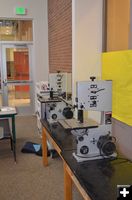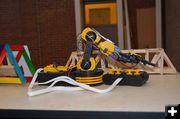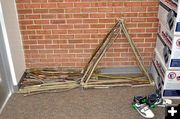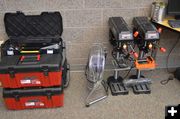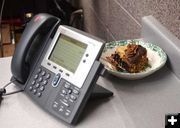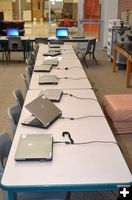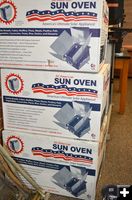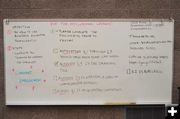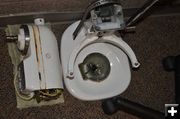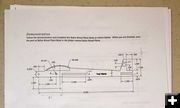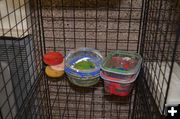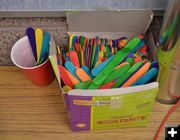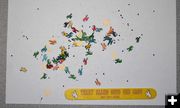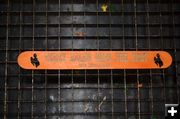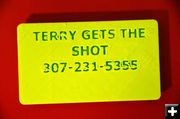Tom the Science Guy rocks Pinedale Middle School
by Terry Allen
April 6, 2015
Tom Kohler, Pinedale Middle School science teacher, seems to be surrounded by a bunch of kids where ever he goes. If you see one tall person surrounded by a bunch of shorter ones, sweeping through the field and woods east of the school, chances are it is Tom and one of his classes. They might be banging on the abandoned well casing, looking under rocks and old boards, stripping down weed stalks to look at internal cell structure, and running to and fro to share their finds with each other. It is impressive to find a teacher that knows the value to the students of getting outside the classroom once in a while.
On occasion, you might find Tom, leading a long trail of kids down the street and into the Food Basket second hand store. If curiosity gets the best of you, and you follow them in, you will see them scattering like a covey of quail to find the old school tool or device each student plans to take back to the classroom to dissect and compare to the modern version.
Recently, Tom was wrestling a big laser from the back of his pickup and was dragging it into his classroom. It is a $500 Chinese copy of a $10,000 American engineered product. Tom and his students plan on testing its quality, and then tearing it apart to see what makes it tick. Upon assembly it is quickly discovered that $500 doesnít buy an internal cooling system like the $10,000 American-made model has. Instead, a hose from the laser sucks ice water out of a five-gallon bucket to cool the high heat generated by the laser. But, after tightening a few screws and taking a quick look at the instruction manual, Tom and his students have turned a wooden tongue depressor into a business card, leaving dozens of little Wyoming Cowboys as a by-product.
If you havenít been in an American middle school science classroom since you were a kid, it might be interesting to pay a visit to see how things have changed.
First, you will get buzzed in the entry door to the Pinedale Elementary School and sign in at the desk and slap an adhesive backed pass on your breast pocket, before heading to Tomís classroom.
Five giant, brightly colored paper macheí heads measuring about three feet across look down on you as you enter the science foyer. You might suspect the one with the wildest hair is an artistic impression of Albert Einstein. Guessing the others might be more challenging. Isaac Newton? Marie Curie? Galileo? Nikola Tesla? Francis Crick? Archimedes?
Long tables with laptops line two sides of the classroom. There are multiple students on multiple computers in multiple windows. There is a student at almost each laptop, except, there are four boys helping one girl at her laptop. Some science is easy to recognize no matter how long it has been since you were in a classroom.
On top of a row of tall cabinets are dozens of brightly colored paper spheres. They are made of a combination of squares, triangles and octagons, enough to make Archimedes and Buckminster Fuller proud. Tom says the students made them while studying crystal structures and Archimedean solids. Further along the wall are several large tool boxes, a couple large drill presses, a couple band saws and a stack of solar ovens. There are three foot triangles of lashed together willow, obviously the result of some sort of geometry study that took place in the great outdoors classroom. Moving around the room your eyes might come to rest on the classroom telephone, with a big slice of chocolate cake hidden behind it. A nearby student is looking at the cake-Tomís break time snack.
Up on top of a file cabinet is a truss bridge, like a train would cross, made of tongue depressors. "A truss bridge is basically made of triangles and is a good way to teach students tension, compression and their response to dynamic loads. It is a simple, yet strong design and a relatively inexpensive way to build bridges, even today," said Tom. Next to it is a spear tipped robotic arm mounted on big tracks. It looks like either an unmanned combat laser or some sort of boulder digger. There is a plastic crate full of robots the students built so they could study how micro-processors work.
On the wall, on a small piece of paper is a quote from George Orwell: "That is an idea that only an intellectual would be foolish enough to believe." Beneath it on the floor is a disassembled cake mixer from the 50ís. Next to that is a CAD drawing of an aircraft wing. Tom is also a FAA certified flight instructor, with ratings for commercial, multi-engine and instruments. Tom is a bit reluctant to share his credentials, saying, "People care more about, if you careÖmore than they care about your big swinging credentialism."
There is a large blackboard, which is actually white. In large letters, students are reminded to use the high school lessons. On it are passwords for the different software required, for working on specific projects. Tom teaches grades 6 Ė 9, which are ages 11 - 14 years old.
Looking at all the projects the students have been involved in, it appears the students will be ahead of the average adult, in no time. "They are already ahead of us," Tom says. "We used to use two-dimensional auto-cad. Now they mostly use parametric modelling software, like Autodesk Inventor, CATIA, and Key Creator. If we were in Europe, they would also be using Solid Works."
Tom pulls a thumb drive out of his laptop. He has just loaded a 3D design he is going to use to make a prototype on his 3D printer. "The kids donít even use these anymore," he said. "They keep their stuff in The Cloud somewhere and access it from anywhere."
3D printing is a process that sequentially depositsa fast drying plastic liquid material onto a flat base surface with inkjet printer heads. Some current applications for industry include: Apparel, Automobile, Construction, Electric motors, Generators, Firearms, Medical devices, Computers and Robots.
Tom sits at his laptop for about 10 seconds, flips the switch on his Cube 3 3D printer and makes this reporter a very green sample business card (see photo). The official company video is here: http://www.cubify.com/en/Cube
Why are there such a variety of projects in a middle school classroom?
"My main goal is to get kids ready for engineering school," said Tom. "I want these kids to someday be able to kick the trash out of Chinese and Russian engineers. I want the Chinese and Russians to read your article and feel a little fear. On top of that, I want the Chinese and Russians to realize that we also let our studentís minds be free and creativeÖand we are still going to win."
One of the most exciting areas of 3D printing that will be available to students when they graduate from college is 3D bioprinting. This is the process of generating 3D structures for the human tissue engineering field of regenerative medicine. 3D bioprinting has seen preliminary success in the generation of several different kinds of human tissues. These include skin, bone, cartilage, trachea, and heart tissue. The cutting edge of 3D printing is research being directed towards the generation of fully functional replacement organs and tissues such as aortic heart valves.
"We still pretty much lead the world in most areas of engineering and I want it to stay that way," said Tom. "The Chinese and Russians copy our designs, and I want them to keep copying our designs, instead of the other way around."
After several emails and finally an opportune meeting at the Food Basket, Tom reluctantly admits his science credentials. "Iím certified in Math at all levels, in Physics and in Technology Education. Iím a highly credentialed idiot."
Photos by Terry Allen
|
